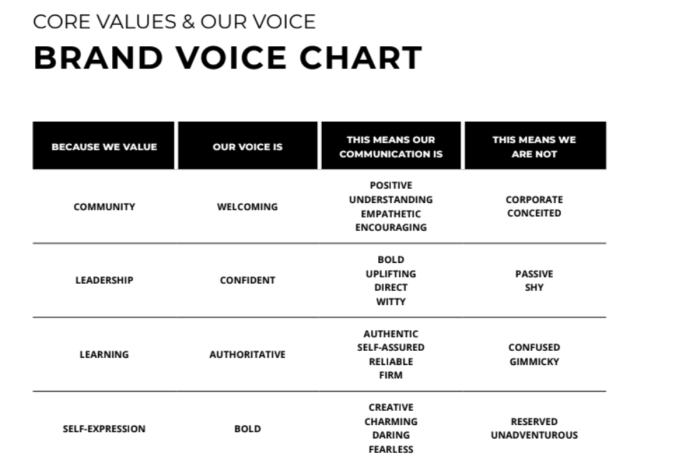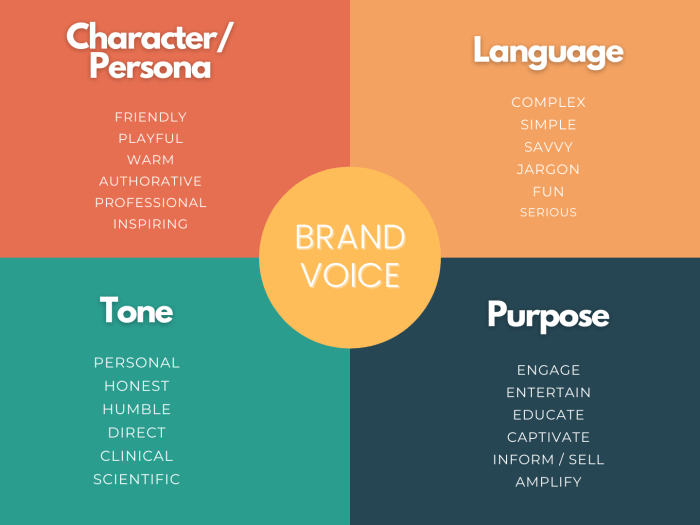Creating a Brand Voice sets the stage for establishing a distinct identity that resonates with your audience, paving the way for successful marketing endeavors filled with personality and charm.
As we delve deeper into the concept, you’ll uncover valuable insights on defining brand voice, developing guidelines, maintaining consistency, and infusing personality into your brand.
Defining Brand Voice
Brand voice is the unique personality and style of a brand that is expressed through its communication with customers. It encompasses the tone, language, and values that the brand conveys in its marketing efforts. Establishing a strong brand voice is crucial in creating a consistent and memorable brand identity that resonates with target audiences.
Examples of Well-Known Brands with Strong Brand Voices
- Apple: Known for its minimalist and sleek design, Apple’s brand voice is sophisticated, innovative, and user-friendly. Their communication is often simple, direct, and focused on delivering a premium experience to customers.
- Nike: With its empowering and motivational brand voice, Nike inspires customers to push their limits and strive for greatness. Their messaging is bold, confident, and inclusive, reflecting their commitment to athletic excellence.
How Brand Voice Influences Customer Perception and Engagement, Creating a Brand Voice
Brand voice plays a significant role in shaping how customers perceive a brand and engage with its products or services. A strong brand voice can help build trust, loyalty, and emotional connections with customers, driving brand affinity and advocacy.
By maintaining a consistent brand voice across all touchpoints, including social media, advertising, and customer service, a brand can create a cohesive brand experience that resonates with its target audience. This consistency helps reinforce the brand’s values, personality, and messaging, ultimately leading to increased customer engagement and brand loyalty.
Developing Brand Voice Guidelines
Creating brand voice guidelines is a crucial step in establishing a consistent and recognizable brand identity. These guidelines serve as a roadmap for how a brand communicates with its audience across different channels. The process involves defining the key elements that make up the brand voice, such as tone, language, and style, and outlining how these should be applied in various situations.
Components of Brand Voice Guidelines
- Brand Personality: Define the characteristics and traits that reflect the brand’s personality, such as friendly, professional, or innovative.
- Tone of Voice: Establish the appropriate tone for different types of communication, whether it’s formal, casual, humorous, or authoritative.
- Language Usage: Specify the vocabulary, grammar, and style preferences that align with the brand’s identity and resonate with the target audience.
- Messaging Guidelines: Artikel key messages, value propositions, and brand stories that should be consistently communicated across all platforms.
- Audience Persona: Describe the target audience in detail to ensure the brand voice resonates with their preferences, needs, and communication styles.
Approaches to Developing Brand Voice Guidelines
- Collaborative Approach: Involves gathering input from various stakeholders, including marketing, design, and customer service teams, to ensure a comprehensive and inclusive brand voice guideline.
- Research-Based Approach: Involves conducting market research, competitor analysis, and audience surveys to inform the development of brand voice guidelines that are data-driven and audience-centric.
- Iterative Approach: Involves testing and refining the brand voice guidelines through feedback, analytics, and A/B testing to continuously optimize and improve the brand’s communication strategy.
Consistency Across Platforms: Creating A Brand Voice

Maintaining a consistent brand voice across various platforms is crucial for establishing brand identity and connecting with your audience effectively. Consistency helps build brand recognition and trust among consumers, no matter where they interact with your brand.
Strategies for Ensuring Consistency
- Develop brand voice guidelines: Create a set of rules and tone of voice that define how your brand communicates. This will ensure consistency in messaging across all platforms.
- Train your team: Educate employees and content creators on the brand voice guidelines to ensure everyone is aligned and consistent in their communication.
- Regularly review and update content: Monitor all platforms to ensure that the brand voice is consistent and relevant. Make adjustments as needed to maintain coherence.
Examples of Successful Brands
- Apple: Apple is known for its sleek and minimalist brand voice, which is consistent across its website, social media, and advertising campaigns. The simplicity and sophistication of their messaging resonate with consumers.
- Nike: Nike’s brand voice is motivational and empowering, encouraging athletes to push their limits. This tone is consistent in their social media posts, website content, and commercials, reinforcing their brand identity.
- Coca-Cola: Coca-Cola maintains a friendly and nostalgic brand voice that is present in their social media interactions, website copy, and print advertisements. This consistency helps create a strong emotional connection with consumers.
Infusing Personality into Brand Voice

Infusing personality into a brand voice is crucial for making it more engaging and memorable. By adding a unique tone, style, and characteristics to your brand voice, you can create a more authentic connection with your audience.
Aligning Brand Voice with Target Audience Preferences
When aligning your brand voice with your target audience preferences, it’s essential to understand their demographics, psychographics, and communication styles. Here are some tips to help you:
- Conduct thorough research to understand your target audience’s preferences, values, and interests.
- Use language and tone that resonates with your audience’s communication style, whether it’s formal, casual, humorous, or professional.
- Tailor your brand voice to match the preferences of different audience segments if you have a diverse target market.
- Solicit feedback from your audience through surveys, focus groups, or social media interactions to refine your brand voice based on their preferences.
Role of Storytelling in Developing a Unique Brand Voice
Storytelling plays a significant role in developing a unique brand voice that resonates with your audience. Here’s why storytelling is essential:
- Stories evoke emotions and create a connection with your audience, making your brand more relatable and memorable.
- Through storytelling, you can convey your brand’s values, mission, and personality in a compelling and engaging way.
- Stories help differentiate your brand from competitors by showcasing your unique perspective, experiences, and authenticity.
- By incorporating storytelling into your brand voice, you can captivate your audience’s attention and leave a lasting impression.